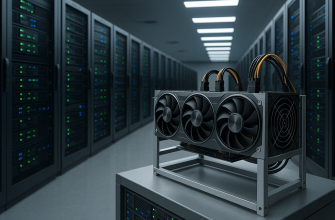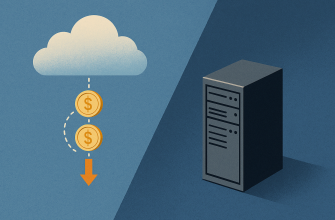- Server Storage: Comparing HDD, SSD, and NVMe Technologies
- Types of Server Storage
- HDD (Hard Disk Drive)
- SSD (Solid-State Drive)
- Interface Types and Their Impact on Performance
- SATA (Serial ATA)
- SAS (Serial Attached SCSI)
- NVMe (Non-Volatile Memory Express)
- NVMe SSD Server Drive Performance Tests
- Testing Parameters Explained:
- NVMe Drives Test Results:
- Comparing Real-World vs. Manufacturer Specifications
- Conclusion
Server Storage: Comparing HDD, SSD, and NVMe Technologies
The performance of hosting or virtual servers (VPS) significantly depends on several key factors. While CPU power and RAM size are typically prioritized, storage technology speed is equally critical. The type of server storage directly influences data processing speed and overall operational efficiency. In this article, we explore the differences between server storage types—HDD, SSD, and NVMe—and analyze performance metrics of high-speed NVMe drives.
Types of Server Storage
Servers primarily use two storage types: HDD and SSD. Hybrid SSHD drives exist but are uncommon due to limited advantages.
HDD (Hard Disk Drive)
HDD technology, widely adopted since the late 20th century, comprises multiple aluminum platters coated magnetically, read/write heads, and a microchip, housed within 2.5 or 3.5-inch drives. Electric motors rotate platters at speeds ranging from 5400 to 15000 RPM. HDD performance is influenced by rotation speed and physical size; 3.5-inch drives typically outperform 2.5-inch drives at the same speed due to greater data coverage per rotation. However, HDDs generate noise, heat, and are vulnerable to vibrations due to mechanical parts.
SSD (Solid-State Drive)
SSDs utilize flash memory chips to store data without moving parts, offering significantly faster data input/output speeds than HDDs. SSDs are energy-efficient, silent, and resistant to physical shocks, although they have higher costs per gigabyte compared to HDDs. Despite their advantages, SSDs are less suitable for long-term storage or backups, as data gradually degrades over time. SSDs also experience performance degradation after prolonged use due to limited write cycles, although even worn SSDs remain considerably faster than HDDs.
Interface Types and Their Impact on Performance
Storage performance is also affected by interface types:
SATA (Serial ATA)
The third-generation SATA interface supports up to 6 Gb/s bandwidth, effectively around 600 MB/s. SATA interfaces process data sequentially, either reading or writing at a given time.
SAS (Serial Attached SCSI)
Originally designed for server applications, SAS interfaces offer bandwidths up to 24 Gb/s, facilitating simultaneous reading and writing through Full Duplex technology. SAS drives typically support HDD rotational speeds up to 15000 RPM.
NVMe (Non-Volatile Memory Express)
NVMe technology significantly enhances SSD performance by supporting up to 16 parallel data transfer channels, each capable of speeds around 2000 MB/s, resulting in a maximum theoretical speed of 32,000 MB/s. NVMe drives handle over one million I/O operations per second (IOPS) and maintain extensive command queues (up to 64,000 queues with 64,000 requests each), greatly optimizing data access efficiency.
NVMe SSD Server Drive Performance Tests
To evaluate the real-world performance of NVMe drives, three enterprise-grade SSDs were tested:
- Intel DC P4510 8TB (SSDPE2KX080T8)
- Kingston DC1500M 1.92TB (SEDC1500M/1920G)
- Intel DC P4610 6.4TB (SSDPE2KE064T8)
Testing Parameters Explained:
- IOPS (Input/Output Operations Per Second): Measures random read/write efficiency using 4KB blocks.
- Bandwidth (BW): Speed of random data read/write operations.
- Latency: Time delay for data retrieval or recording, measured in microseconds (µs). Lower values indicate better responsiveness.
- Sequential Read/Write Speeds: Measured using Linux utility ‘DD’, representing sustained data transfer rates.
NVMe Drives Test Results:
| Model | Random Read IOPS (k) | Random Write IOPS (k) | Latency (µs) | Seq. Read (GB/s) | Seq. Write (GB/s) |
|---|---|---|---|---|---|
| Intel DC P4510 | 125 | 36.8 | 153.85 | 1.1 | 2.3 |
| Kingston DC1500M | 92.8 | 31 | 128.9 | n/a | n/a |
| Intel DC P4610 | 255 | 74.6 | 101 | 1.6 | 1.7 |
IOPS in thousands (k), BW in MiB/s, Latency in microseconds.
Comparing Real-World vs. Manufacturer Specifications
Real-world tests generally showed lower performance than manufacturers’ lab-based maximum specifications. This discrepancy is normal due to different testing conditions and natural wear on drives. For instance, Intel DC P4510 officially advertises sequential read/write speeds of up to 3.1/2.9 GB/s, significantly higher than practical test results but consistent with industry averages under operational conditions.
Conclusion
Despite real-world performance differences from ideal manufacturer benchmarks, NVMe SSDs clearly outperform HDDs and SATA SSDs. The exceptional speeds and efficiencies of NVMe drives make them increasingly popular in server and hosting environments, signifying a technological shift toward high-performance, robust storage solutions.









